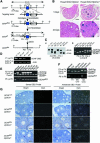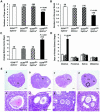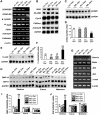GCNF-dependent repression of BMP-15 and GDF-9 mediates gamete regulation of female fertility
- PMID: 12912906
- PMCID: PMC175795
- DOI: 10.1093/emboj/cdg405
GCNF-dependent repression of BMP-15 and GDF-9 mediates gamete regulation of female fertility
Abstract
To determine the function of germ cell nuclear factor (GCNF) in female reproduction, we generated an oocyte-specific GCNF knockout mouse model (GCNF(fl/fl)Zp3Cre(+)). These mice displayed hypofertility due to prolonged diestrus phase of the estrous cycle and aberrant steroidogenesis. These reproductive defects were secondary to a primary defect in the oocytes, in which expression of the paracrine transforming growth factor-beta signaling molecules, bone morphogenetic protein 15 (BMP-15) and growth differentiation factor 9 (GDF-9), were up-regulated in GCNF(fl/fl)Zp3Cre(+) females at diestrus. This was a direct effect of GCNF, as molecular studies showed that GCNF bound to DR0 elements within the BMP-15 and GDF-9 gene promoters and repressed their reporter activities. Consistent with these findings, abnormal double-oocyte follicles, indicative of aberrant BMP-15/GDF-9 expression, were observed in GCNF(fl/fl)Zp3Cre(+) females. The Cre/loxP knockout of GCNF in the oocyte has uncovered a new regulatory pathway in ovarian function. Our results show that GCNF directly regulates paracrine communication between the oocyte and somatic cells by regulating the expression of BMP-15 and GDF-9, to affect female fertility.
Figures






Similar articles
-
Differential oocyte-specific expression of Cre recombinase activity in GDF-9-iCre, Zp3cre, and Msx2Cre transgenic mice.Biol Reprod. 2004 Nov;71(5):1469-74. doi: 10.1095/biolreprod.104.031757. Epub 2004 Jun 23. Biol Reprod. 2004. PMID: 15215191
-
Synergistic roles of bone morphogenetic protein 15 and growth differentiation factor 9 in ovarian function.Mol Endocrinol. 2001 Jun;15(6):854-66. doi: 10.1210/mend.15.6.0662. Mol Endocrinol. 2001. PMID: 11376106
-
Developmental and molecular aberrations associated with deterioration of oogenesis during complete or partial follicle-stimulating hormone receptor deficiency in mice.Biol Reprod. 2003 Oct;69(4):1294-302. doi: 10.1095/biolreprod.103.015610. Epub 2003 Jun 11. Biol Reprod. 2003. PMID: 12801992
-
Oocyte-expressed TGF-beta superfamily members in female fertility.Mol Cell Endocrinol. 2000 Jan 25;159(1-2):1-5. doi: 10.1016/s0303-7207(99)00185-9. Mol Cell Endocrinol. 2000. PMID: 10687846 Review.
-
Oocyte-somatic cell interactions in the human ovary-novel role of bone morphogenetic proteins and growth differentiation factors.Hum Reprod Update. 2016 Dec;23(1):1-18. doi: 10.1093/humupd/dmw039. Epub 2016 Oct 26. Hum Reprod Update. 2016. PMID: 27797914 Free PMC article. Review.
Cited by
-
The function of nuclear receptors in regulation of female reproduction and embryogenesis in the red flour beetle, Tribolium castaneum.J Insect Physiol. 2010 Oct;56(10):1471-80. doi: 10.1016/j.jinsphys.2010.04.004. Epub 2010 Apr 27. J Insect Physiol. 2010. PMID: 20416316 Free PMC article.
-
The expanding roles of Nr6a1 in development and evolution.Front Cell Dev Biol. 2024 Feb 19;12:1357968. doi: 10.3389/fcell.2024.1357968. eCollection 2024. Front Cell Dev Biol. 2024. PMID: 38440075 Free PMC article. Review.
-
Pregnancy Toxemia in Ewes: A Review of Molecular Metabolic Mechanisms and Management Strategies.Metabolites. 2023 Jan 18;13(2):149. doi: 10.3390/metabo13020149. Metabolites. 2023. PMID: 36837768 Free PMC article. Review.
-
Granulosa cell-expressed BMPR1A and BMPR1B have unique functions in regulating fertility but act redundantly to suppress ovarian tumor development.Mol Endocrinol. 2010 Jun;24(6):1251-66. doi: 10.1210/me.2009-0461. Epub 2010 Apr 2. Mol Endocrinol. 2010. PMID: 20363875 Free PMC article.
-
Germ cell nuclear factor regulates gametogenesis in developing gonads.PLoS One. 2014 Aug 20;9(8):e103985. doi: 10.1371/journal.pone.0103985. eCollection 2014. PLoS One. 2014. PMID: 25140725 Free PMC article.
References
-
- Agoulnik I.Y., Cho,Y., Niederberger,C., Kieback,D.G. and Cooney,A.J. (1998) Cloning, expression analysis and chromosomal localization of the human nuclear receptor gene GCNF. FEBS Lett., 424, 73–78. - PubMed
-
- Braat A.K., Zandbergen,M.A., De Vries,E., Van Der Burg,B., Bogerd,J. and Goos,H.J. (1999) Cloning and expression of the zebrafish germ cell nuclear factor. Mol. Reprod. Dev., 53, 369–375. - PubMed
-
- Chen F., Cooney,A.J., Wang,Y., Law,S.W. and O’Malley,B.W. (1994) Cloning of a novel orphan receptor (GCNF) expressed during germ cell development. Mol. Endocrinol., 8, 1434–1444. - PubMed
Publication types
MeSH terms
Substances
Grants and funding
LinkOut - more resources
Full Text Sources
Other Literature Sources
Molecular Biology Databases

